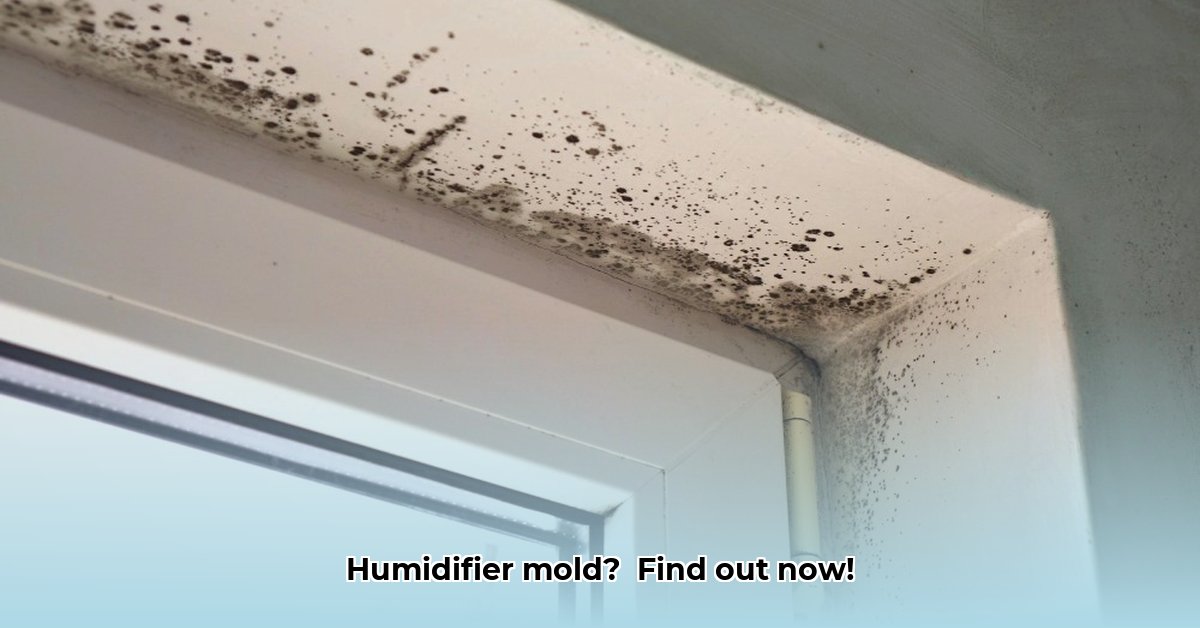Humidifiers can be great for dry winter air, but they can also lead to mold if you’re not careful. This guide will show you exactly how to use a humidifier safely, so you can enjoy the benefits without worrying about mold. We’ll cover everything from choosing the right humidifier to cleaning it properly and keeping your humidity levels just right. Let’s make sure your humidifier keeps your home healthy and comfortable!
Do Humidifiers Cause Mold? Understand the Risks
Let’s talk honestly about humidifiers and mold and determine if there’s a cause. The short answer is a little complicated: humidifiers can contribute to mold growth, but they absolutely don’t have to. It’s all about how you use and maintain them. Think of it like this: a humidifier is a helpful tool, like a favorite kitchen appliance. With proper care, it’s a lifesaver on those dry winter days. Without the right care, it could become a moldy mess.
Humidifiers and Mold: Understanding the Connection
Humidifiers add moisture to the air, and what thrives in damp, moist environments? Mold! Mold spores are everywhere, just waiting for the perfect opportunity to grow. A consistently damp environment, even one created by your humidifier, is an open invitation for mold to set up shop. The key is to keep things balanced – just the right amount of moisture, not too much, not too little.
Mold requires a few key ingredients to flourish: moisture, a food source (like dust or organic material), and a suitable temperature. Humidifiers, by their very nature, increase the moisture content in the air. If humidity levels rise above the recommended range, especially in poorly ventilated areas, you’re essentially creating the perfect breeding ground for mold.
Preventing Mold: Your Humidifier’s Best Friend (and Yours!)
Here’s how to keep your humidifier working for you, not against you. These steps are simple, but they’re crucial for preventing mold growth.
1. Embrace Distilled Water: Tap water has minerals, which leave behind a sticky residue inside your humidifier, a perfect buffet for mold spores. Use distilled water instead. It’s like giving your humidifier a clean slate every time you fill it. Distilled water has been purified, removing the minerals and impurities that can contribute to mold and bacterial growth.
2. Clean Regularly – It’s Easier Than You Think: How often do you clean your coffee maker? Your humidifier needs similar attention; remember, it’s constantly working with water. Aim to clean it thoroughly every 3-7 days (check your manufacturer’s instructions – some need more frequent cleaning). A simple solution of white vinegar and water works wonders – it’s effective, safe, and readily available.
3. Empty and Dry Completely After Every Use: Never leave water standing in your humidifier. This is like leaving a welcome mat out for mold. Empty the tank and let the entire unit air dry completely before storing or using it again. Proper drying prevents mold from establishing itself.
4. Monitor Humidity Levels: The Goldilocks Approach: Aim for a relative humidity between 30-50%. A hygrometer is your best friend here; it measures the humidity level in your home so you know exactly what’s going on. Too much humidity, and you’re creating a spa day for mold. Too little, and you’re back to battling dry skin and scratchy throats. A humidistat will automatically adjust the amount of moisture released, helping to keep your humidity levels just right. Many modern humidifiers have built-in humidistats, making it even easier to maintain optimal levels.
5. Replace Filters Regularly: Clean Air is Happy Air: Humidifier filters trap dust and other particles. These particles, combined with moisture, can turn into a moldy cocktail. Replace filters according to manufacturer’s recommendations, typically every few months. Regular filter replacement helps ensure that your humidifier is releasing clean, healthy air.
6. Regular Inspections: Catch Mold Early: Regularly inspect your humidifier for signs of mold. This includes checking the tank, the filter, and any other parts that come into contact with water. Look for any discoloration, whether it’s black, green, or gray. A musty odor is another telltale sign. Addressing a small problem early is much easier than dealing with a large infestation.
7. Consider the Type of Humidifier: Several humidifiers exist; evaporative, ultrasonic, and impeller varieties. Each functions slightly differently and impacts the likelihood of mold growth. Research your specific model and follow the manufacturer’s instructions on cleaning and maintenance.
- Evaporative Humidifiers: These use a wick or filter to absorb water, which is then evaporated by a fan. They’re generally considered less prone to spreading mold spores because the wick filters out some impurities. However, wicks need regular replacement to prevent mold growth within the filter itself.
- Ultrasonic Humidifiers: These use high-frequency sound vibrations to create a fine mist. They don’t have filters, so they can disperse minerals and impurities from tap water into the air, potentially contributing to mold growth on surfaces. Using distilled water is particularly important with ultrasonic humidifiers.
- Impeller Humidifiers: These use a rotating disk to fling water onto a diffuser, creating a cool mist. Like ultrasonic humidifiers, they can disperse minerals and impurities if tap water is used.
Whole-House Humidifiers: A Bigger Responsibility
Whole-house humidifiers are powerful moisture-makers. This means they need even more careful cleaning and maintenance than smaller units. Regular professional servicing is highly recommended. Mold growth in your HVAC system is a serious issue best left to the professionals. Think of it like this: you wouldn’t service your car’s engine yourself if you didn’t know how – same with a whole-house humidifier. Whole-house humidifiers are typically integrated into your home’s HVAC system, making them more complex to clean and maintain.
Finding Mold: What to Do
Discovering mold isn’t the end of the world. Act quickly. Clean the affected areas thoroughly. For small areas, a solution of bleach and water (1 part bleach to 10 parts water) can be effective. However, always wear gloves and eye protection when working with bleach. For extensive mold growth, definitely call in a professional. They have the expertise and equipment to safely and effectively remove the mold and prevent it from returning. Professionals often use specialized equipment like air scrubbers and HEPA vacuums to remove mold spores and prevent them from spreading during the remediation process. They can also identify and address the underlying cause of the mold growth, such as leaks or excessive humidity.
The Bottom Line: It’s About Prevention
The real question isn’t “Do humidifiers cause mold?” It’s “How can I prevent mold growth in my humidifier?” With the right care and attention, a humidifier can be a valuable asset, providing relief from dry air without becoming a moldy menace. Remember, regular cleaning, proper maintenance, and monitoring humidity levels are your best defenses against mold. Regularly inspect your humidifier, and don’t hesitate to call in the professionals if you suspect mold. Ongoing research continues to refine our understanding of mold growth and prevention strategies, and we’ll keep you updated to the best of our ability.
How to prevent mold growth in whole-house humidifiers and HVAC systems
Key Takeaways:
- Whole-house humidifiers, while beneficial for comfort, significantly increase mold risk if neglected.
- Regular cleaning and distilled water are crucial for preventing mold in your humidifier.
- Maintaining the ideal humidity level (30-50%) is vital.
- Your HVAC system also needs attention to prevent mold growth.
- Annual professional maintenance is highly recommended to avoid mold remediation.
Understanding the Mold Threat
Do you worry about mold lurking in your HVAC system? It’s a valid concern. Whole-house humidifiers add moisture, creating a perfect breeding ground for mold if not properly managed. It’s not just the humidifier itself; the entire HVAC system is at risk. Dust, darkness, and warmth within your ductwork create an ideal environment.
The evaporator coil, located within your HVAC system, is a prime location for mold growth. This coil cools the air, which creates condensation. If the coil isn’t properly cleaned and maintained, mold can quickly take hold. Blocked drainage pipes, caused by algae growth, can create overflow and contribute to standing moisture inside the HVAC system.
How to prevent mold growth in whole-house humidifiers and HVAC systems: A Step-by-Step Guide
Here’s how to keep your home’s air fresh and mold-free:
-
Embrace Distilled Water: Use only distilled water in your humidifier. Tap water contains minerals that encourage mold growth. It’s a simple swap with big benefits.
-
Regular Cleaning Ritual: Clean your humidifier weekly. This prevents mineral buildup and mold spores from taking hold. Follow your manufacturer’s instructions for cleaning. For many, a simple solution of white vinegar and water will suffice; however, always defer to your manufacturer’s guidance on cleaning solutions and procedures. A general recommendation is to use a solution of 1 part white vinegar to 1 part water.
-
Evaporator Pad Replacement: Replace your humidifier’s evaporator pads annually. These pads accumulate dust and moisture, becoming mold havens if not changed. It’s a small investment for big results.
-
Humidity Control: Maintain your home’s relative humidity between 30-50%. A humidist
- Gluten Free Meal Prep Ideas for Delicious, Hassle-Free Eating - November 28, 2025
- Gluten Free Meal Prep for Stress-Free and Healthy Eating - November 27, 2025
- Quick And Easy Chicken Thigh Meal Prep For Weight Loss - November 26, 2025










